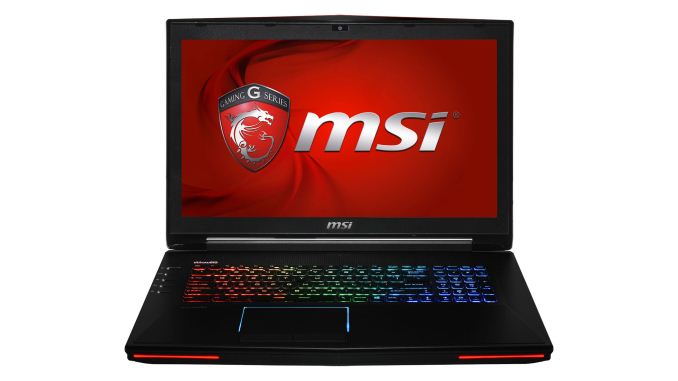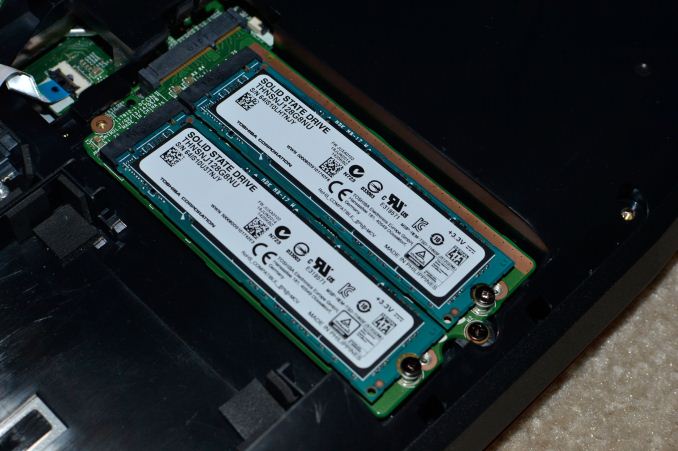MSI GT72 Dominator Pro Review: GTX 980M Reigns Supreme
by Jarred Walton on November 11, 2014 8:00 AM EST
MSI GT72 Dominator Pro Introduction
MSI has several lines of gaming notebooks catering to different types of users. In the past few months we've looked at MSI's top-of-the-line GT70 Dominator Pro with NVIDIA's GTX 880M GPU, the GE60 Apache Pro with GTX 860M, and the GS60 Ghost Pro 3K with GTX 870M. It’s been a long time in coming, but after many years we finally have an updated chassis for MSI’s top gaming notebook, the new GT72 Dominator Pro. We’ve already previewed the gaming performance of the GT72, and we did a detailed look at NVIDIA’s BatteryBoost with the laptop; now it’s time to bring everything together for the full review.
When it comes to high-end gaming notebooks, there are only a few real competitors: Alienware, ASUS, Clevo (under various brand names), and MSI are the main options, with a few others like Razer and Gigabyte offering second tier performance (e.g. not the 880M or 980M, but instead dropping one step to the 870M and 970M). [Ed: Gigabyte is now joining the ranks of companies offering GTX 980M with the P35X V3.] The NVIDIA GeForce GTX 980M officially launched in the first half of October, and it wasn’t too much of a surprise to see it come out ahead of all other mobile contenders. Maxwell 2 (GM204) proved quite potent in desktop GPUs like the GTX 980, and the notebook counterpart is equally capable. For our testing, MSI shipped us the third highest configuration of their GT72 Dominator Pro, with four 128GB SSDs in SuperRAID to help keep storage as fast as possible. Here are the full specifications:
| GT72 Dominator Pro-208 Specifications | |
| CPU | Core i7-4710HQ (Quad-core, 2.5-3.5GHz, 6MB L3, 47W) |
| GPU | NVIDIA GeForce GTX 980M 8GB (1536 CUDA cores, 1038MHz + Boost, 256-bit 5010MHz GDDR5) Intel HD Graphics 4600 |
| RAM | 32GB (4x8GB) DDR3L-1600 |
| SSD | 512GB M.2 SATA SSD Array (4x128GB Toshiba THNSNJ128G8NU in RAID 0) |
| HDD | 1TB 7200RPM |
| Optical | Blu-ray Burner 9.5mm |
| Display | 17.3" Anti-Glare 1080p (1920x1080) (Chi Mei N173HGE-E11) |
| Networking | Killer e2200 Gigabit Ethernet Killer N1525 Combo (2x2 802.11ac + BT 4.0) |
| Audio | Realtek ALC892 2.1 speakers Four audio jack |
| Front | N/A |
| Left | Flash Reader (SDXC/SDHC) 4 x Audio jacks 4 x USB 3.0 |
| Right | Optical Drive 2 x USB 3.0 |
| Rear | Left/Right Exhaust Vents 2 x mini-DisplayPort 1.2 1 x HDMI 1.4 Ethernet AC Adapter |
| Input | 101 Key SteelSeries Keyboard Multi-touch Touchpad |
| Power | 9-cell ~87Wh battery 230W AC adapter |
| Extras | Full HD webcam (1080p30) Configurable Multi-colored Backlighting Anti-Ghost Key Shift Cooling Switchable Graphics |
| OS | Windows 8.1 Multi-Language |
| Dimensions | 16.85" x 11.57"x 1.89" (428mm x 294mm x 48mm) |
| Weight | 8.4 lbs. (3.82kg) |
| Pricing | $3000 MSRP $2900 Online |
Obviously this is close to the maximum level of performance you might get from any modern gaming notebook. If you want more performance than this in a notebook, your only options are GTX 980M SLI and/or a faster CPU. MSI does have two higher models of the GT72 available that upgrade the CPU to the Core i7-4980HQ (which means you get Crystalwell’s embedded DRAM and Iris Pro Graphics 5200 along with a 300-500MHz bump in clock speed), but the lesser of the two options still costs $3300, so you’re basically paying $400 more for the CPU upgrade over the system we received. If you’re thinking of that upgrade, there’s another model with 4x256GB SSD and the i7-4980HQ for $3800.
Getting back to our review sample, while I’m still not sold on the need for four separate M.2 SSDs, I can say that there’s a ton of storage bandwidth available. In the process of getting the gaming library copied over, a few games sometimes require Steam to validate the files, and the GT72 does that faster than any other system I’ve tested. So yes, having more than 1GB/s of storage throughput can be beneficial. On the other hand, the cost of the storage upgrades is much higher than what you’d typically pay for SSDs. As an example, a 1TB Samsung 850 Pro can be had for $650; going from the base $2284 GT72 with a 128GB single SSD to 512GB with four 128GB SSDs and doubling the RAM to 32GB from 16GB currently adds $616 to the price. The RAM upgrade costs roughly $150, so in effect you’re paying $466 for an additional 384GB of storage.
Of course, finding the Toshiba THNSNJ128G8NU 128GB or Toshiba THNSNJ256G8NU 256GB M.2 SSDs for sale can be a bit tricky; I’ve seen them in Europe for around £65/£113 (around $100/$180 USD), so the problem isn’t just that MSI is overcharging for the parts but that the parts are also rather expensive to begin with. Considering the final price looks to be upwards of $720 for 4x256GB of storage, it might have been better to offer two 2.5” drives instead. That would allow users to install two 512GB SSDs for around $400-$500, and while you might give up a bit of raw performance in practice I don’t think the difference would be noticeable. Anyway, MSI has chosen to stick with multiple M.2 SATA drives, so that’s what you get.
The remaining components and features look good, including four SO-DIMM slots with support for up to 32GB RAM, 802.11ac WiFi with up to 867Mbps connectivity, and six (!) USB 3.0 ports. Probably the only real flaw in the specifications is the LCD, which is the same Chi Mei N173HGE that was in the MSI GT70 prior to this. The LCD identifies as an “E11” compared to the “L11” in the GT70 we have, but it’s still a TN panel.
There is a bit of good news regarding the LCD, however. There are a few sites listing the GT72 with an IPS panel (e.g. XoticPC and Amazon), and after contacting MSI we were able to confirm that there are certain models of the GT72 that do indeed have an IPS display. There's a catch, unfortunately: the only two models with the IPS display right now are the 445 and 444, which cost $3300 and $3800 respectively. Both feature the faster i7-4980HQ CPU along with the IPS display, and the 444 comes with four 256GB SSDs for a total of 1TB of SSD storage… but wow, that's a lot of money to spend on a notebook!











57 Comments
View All Comments
abianand - Tuesday, November 11, 2014 - link
the question is, is it worth spending close to $3000 on a laptop that1. has 192W of heat dissipation on your lap (47W from CPU + 145W from the GPU if I am not wrong)
2. weighs 3.8kg (a dumbbell comes to mind)
3. has a high battery-power consumption driven by that kind (192W-kind) of a heat dissipation and the fan speeds needed to handle that
4. costs maybe 4 times as a desktop that gives you roughly the same performance (unless you really want the 1.5TB of space to store and play 30 games at the same time !!! )
daku123 - Tuesday, November 11, 2014 - link
No :)nathanddrews - Tuesday, November 11, 2014 - link
No, it's not. I'll take one.abianand - Tuesday, November 11, 2014 - link
I correct myself, the GPU is 125W, not 145W.But the point still stands.
It's still a toaster running at 172W peak heat output.
zodiacsoulmate - Tuesday, November 11, 2014 - link
when you are on battery it can only go up to 100W... all tests are on AC if they test it on battery FPS will drop half probably...Jer Stryker - Tuesday, November 11, 2014 - link
There are always comments like this whenever a gaming notebook is reviewed. It's a niche market, stated several times in the article. There are people (like me, I'm an airline pilot) who travel a lot, or for whatever reason need what basically amounts to a portable desktop. I've pretty much never used one of these as a "lap" top. Does it make more sense for me to spend $1500 on a gaming desktop that I have access to half the time, or $2500 on something I can use every day? Is it expensive? Yes! Is it heavy? Yes!! Is it worth it? I think so. I know several people who game on lighter, cheaper notebooks with the settings turned way down, and others who have resorted to gaming on *shudder* tablets. That's not for me. I'll lug my $3000 dumbell into my hotel room and game away.That being said, I'm strongly considering a Gigabyte P35X V3. It has a 980M and an IPS screen (with a 3K option available), but is a 15.6" machine weighing only 2.2kg. If the cooling isn't terrible (and early reports are that it gets the job done) I may just be able to have my cake and eat it too.
jwhannell - Wednesday, November 12, 2014 - link
Also there are a lot of professionals who travel a great deal for work, but want to game. This kind of machine is ideal for that. Personally, I have one of these as a desktop replacement that I bring to and from work everyday. Sure it only gets 3 hours on battery power while all i'm doing is browsing the web, but that's enough for my longest meetings. Meanwhile I am able to have nearly desktop performance w/ additional flexibility.MDX - Saturday, November 15, 2014 - link
Well said. What these laughable "comparison" posters also always inevitably forget about is the cost of peripherals. The laptop comes with a display, keyboard, touch interface device, and speakers, in addition to the 'hardware' that the naysayers are so pantie-bunching about.To keep things in tune with this comment, comparing a laptop to a desktop is like comparing an airplane to a car. It just can't be done, and to attempt it is ludicrous.
Wolfpup - Tuesday, November 25, 2014 - link
Plus, however "big" people allege high end notebooks are, they're tiny and light compared with what, dragging a mini-tower and monitor and keyboard around?Wolfpup - Tuesday, November 25, 2014 - link
Well said. I don't know why people always have to chime in with "It's so expensive!" Even saw a "review" of an Alienware 17 on Amazon that was just (in all caps, of course) THIS IS TO ESPENSIVE NO OEN NEEDMost of those points aren't even points. Yeah, it can use a lot of power (by notebook standards). So what? And yeah, it's heavier than lots of notebooks. So what? It's still plenty light enough to take with you.
I use an Alienware M17x-R4 (typing on it right now) and I LOVE that it gets me reasonable performance, and has cooling that lets me actually push it, whether with games, video encoding, or just having 90 bajillion programs open (or all three, as I'm doing right now LOL)